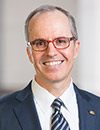8:30 AM - 8:35 AM:
Welcome and introduction
8:35 AM - 8:45 AM:
Award announcements
- Robert F. Wagner Award finalists for conferences 12927, 12928, and 12932
- Computer-Aided Diagnosis Best Paper Award, sponsored by:

- Image-Guided Procedures, Robotic Interventions, and Modeling Student Paper and Early-Career Investigator Award, sponsored by:


8:45 AM - 9:25 AM:
Clinical translation of machine learning for medical imaging

Curtis Langlotz, Stanford Univ. (United States)
Artificial intelligence and machine learning (AI/ML) are powerful tools for building computer vision systems that support the work of clinicians, leading to high interest and explosive growth in the use of these methods to analyze clinical images. These promising AI techniques create computer vision systems that perform some image interpretation tasks at the level of expert radiologists. In radiology, deep learning methods have been developed for image reconstruction, imaging quality assurance, imaging triage, computer-aided detection, computer-aided classification, and radiology documentation. The resulting computer vision systems are being implemented now and have the potential to provide real-time assistance, thereby reducing diagnostic errors, improving patient outcomes, and reducing costs. We will show examples of real-world AI applications that indicate how AI will change the practice of medicine and illustrate the breakthroughs, setbacks, and lessons learned that are relevant to medical imaging.
Curtis Langlotz is Professor of Radiology, Medicine, and Biomedical Data Science, and Director of the Center for Artificial Intelligence in Medicine and Imaging (AIMI Center) at Stanford University. The AIMI Center comprises over 150 faculty from across Stanford who conduct interdisciplinary machine learning research that optimizes how clinical data are used to promote health. Dr. Langlotz’s laboratory investigates the use of deep neural networks and other machine learning technologies to help physicians detect disease and eliminate diagnostic errors. He has led many national and international efforts to improve medical imaging, including the RadLex terminology standard and the Medical Imaging and Data Resource Center (MIDRC), a U.S. national imaging research resource.
This keynote is part of the Computer-Aided Diagnosis conference.
9:25 AM - 10:05 AM:
Beyond the visible: The true state of AI in medical imaging

Lena Maier-Hein, German Cancer Research Center (DKFZ) (Germany)
Intelligent medical systems adept at acquiring and analyzing sensor data to offer context-sensitive support are at the forefront of modern healthcare. However, various factors, often not immediately apparent, significantly hinder the effective integration of contemporary machine learning research into clinical practice. Using insights from my own research team and extensive international collaborations, I will delve into prevalent issues in current medical imaging practices and offer potential remedies. My talk will highlight the vital importance of challenging every aspect of the medical imaging pipeline from the image modalities applied to the validation methodology, ensuring that intelligent imaging systems are primed for genuine clinical implementation.
Lena Maier-Hein is a managing director of the National Center for Tumor Diseases (NCT) Heidelberg and division head at the German Cancer Research Center (DKFZ). Her research concentrates on machine learning-based biomedical image analysis with a specific focus on surgical data science, computational biophotonics and validation of machine learning algorithms. She has been distinguished with several science awards including the 2013 Heinz Maier Leibnitz Award of the German Research Foundation (DFG) and the 2017/18 Berlin-Brandenburg Academy Prize. She has further received a European Research Council (ERC) starting grant (2015-2020) and consolidator grant (2021-2026).
This keynote is part of the Procedures, Robotic Interventions, and Modeling conference.
10:05 AM - 10:45 AM:
From dolphins in the sea to stars in the sky: the inspired birth of ultrasound tomography

Neb Duric , Univ. of Rochester, Delphinus Medical Technologies (United States)
Ultrasound tomography (UST) is an emerging medical imaging modality that has found its way into clinical practice after its recent approval by the Food and Drug Administration (FDA) for breast cancer screening and diagnostics. As an active area of research, UST also shows promise for applications in brain, prostate, limb and even whole-body imaging.
The historical development of ultrasound tomography is rooted in the idea of “seeing with sound” and the concept borrows heavily from diverse disciplines, including oceanography, geophysics and astrophysics. A brief history of the field is provided, followed by a review of current reconstruction methods and imaging examples.
Unlike other imaging modalities, ultrasound tomography in medicine is computationally bounded. Its future advancement is discussed from the perspective of ever-increasing computational power and Moore's Law.
Neb Duric received his PhD in Astronomy and Astrophysics from the University of Toronto. After a 20-year astrophysics career, he embarked on a new career in medical imaging, first at Wayne State University in Michigan and now at the University of Rochester in New York where he serves as Professor and Vice Chair of Research in the Imaging Sciences Department. He has been a leader in the development of ultrasound tomography and its ultimate commercialization for breast cancer screening by Delphinus Medical Technologies, the company he co-founded in 2010. In recognition of his work, he received the Michigan Innovator of the Year Award from the state of Michigan and a Distinguished Innovator Award from Wayne State University. He was also named a Hero of Breast Cancer by the Detroit Chapter of Race for the Cure, recognizing excellence in breast cancer research and education. Neb has over 200 publications and has received numerous research grants, from sponsors that include NIH, NSF, DoD and NASA.
This keynote is part of the Ultrasonic Imaging and Tomography conference.
Event Details
FORMAT: General session with live audience Q&A to follow each presentation.MENU: Coffee, decaf, and tea will be available outside presentation room.
SETUP: Assortment of classroom and theater style seating. .
